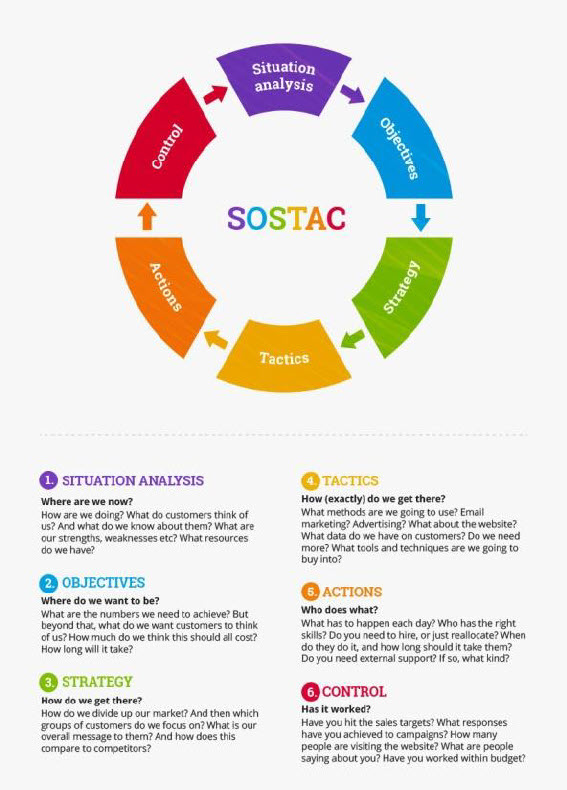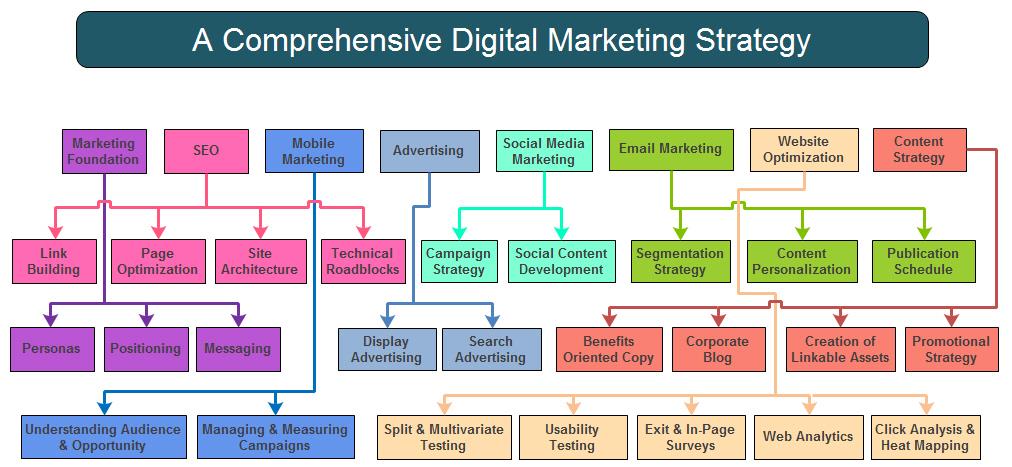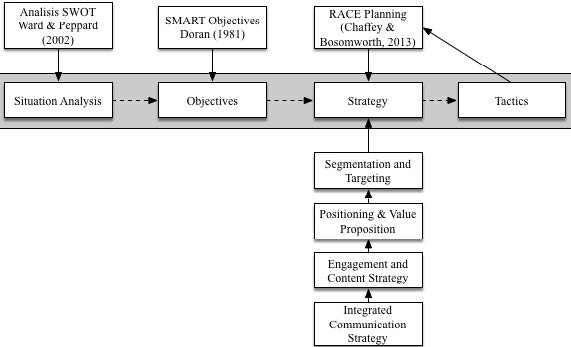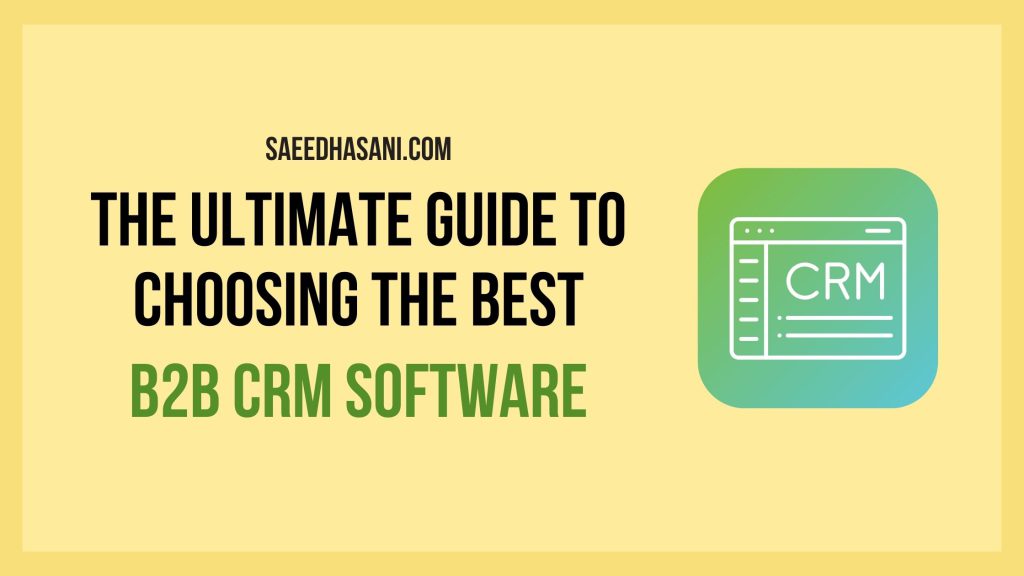7 SOSTAC marketing plan: Enhancing Marketing Expertise with Proven Strategies!

Are you struggling to create a winning marketing plan that drives results? Look no further! In this blog post, we’ll introduce you to the powerful SOSTAC marketing plan – your secret weapon for crafting marketing strategies that deliver real impact.
The SOSTAC marketing plan, developed by marketing guru Paul Smith, is not just another acronym. It’s a structured framework that guides you through every step of the marketing journey, ensuring you cover all the critical aspects of planning and execution.
Picture this: you’ll gain clarity and structure, make informed decisions, allocate resources efficiently, adapt to changing landscapes, and align your marketing team for maximum impact. With the SOSTAC marketing plan, you’ll be equipped to achieve measurable results and long-term success.
In this blog post: we’ll delve into the SOSTAC model, exploring its components – Situation Analysis, Objectives, Strategy, Tactics, Action, and Control – and how they work together to create a comprehensive marketing plan. We’ll also highlight the benefits of using SOSTAC, how it differs from other marketing planning models, and provide you with seven practical examples of SOSTAC marketing plans that you can draw inspiration from.
So, if you’re ready to elevate your marketing game and create winning strategies, keep reading and discover the world of SOSTAC marketing planning. Your journey to marketing success starts here!
Content Overview:
What is the SOSTAC marketing plan and how does it work?
So, the SOSTAC marketing plan is like your trusty roadmap for crafting and executing marketing strategies. It’s an acronym that stands for Situation Analysis, Objectives, Strategy, Tactics, Action, and Control. Think of it as your go-to guide for tackling marketing challenges.
Situation Analysis: This is where you take a deep dive into what’s happening in the market and your own backyard. You’re basically Sherlock Holmes, analyzing the strengths and weaknesses of your business (that’s the “S” and “W” in SWOT), checking out what opportunities and threats are lurking around, and keeping tabs on your competitors.
Objectives: Now that you’ve got the lay of the land, it’s time to set some goals. These are the ‘what’ and ‘why’ of your marketing efforts. Want to boost sales, raise brand awareness, or engage more customers? That’s what you’re nailing down here.
Strategy: This is where you put on your general’s hat. You’re devising the master plan for how to achieve those objectives. Think about your target audience, your unique selling points, and how you’ll position yourself in the market. It’s the ‘how’ part of the equation.
Tactics: Now, you’re getting into the nitty-gritty. Tactics are your actionable steps. It’s where you choose the specific tools in your marketing toolbox—like content marketing, email campaigns, social media, or maybe some good old-fashioned billboards—to execute your strategy.
Action: This is where the rubber meets the road. You’re assigning tasks, setting deadlines, and getting everyone on your marketing team in gear. It’s the ‘who,’ ‘what,’ and ‘when’ of your marketing operation.
Control: Last but not least, you’re keeping a watchful eye. In the control phase, you’re measuring your progress, checking if you’re hitting those goals you set in the objectives phase. If things aren’t going according to plan, you’ve got the chance to pivot and tweak your strategy.
So, there you have it, the SOSTAC marketing plan in a nutshell. It’s like your trusted GPS for navigating the marketing landscape, helping you stay on course and adjust your route when needed.

SOSTAC digital marketing plan
Let’s talk about the SOSTAC digital marketing plan – it’s like the secret sauce for acing your online marketing game.
Situation Analysis: First things first, you gotta scope out the digital landscape. What’s happening in your niche online? Who are your digital competitors? Are there any new trends or tech that you can leverage? It’s all about getting the lay of the digital land.
Objectives: Now, think big picture. What do you want to achieve in the digital realm? Is it boosting your website traffic, converting more leads, or conquering social media? Set clear digital goals that align with your overall marketing strategy.
Strategy: Time to plot your digital course. Your strategy here is like the battle plan. Who’s your target online audience? How will you engage them? What platforms and channels will you conquer – social media, SEO, email marketing, or maybe PPC ads? It’s about crafting your unique digital game plan.
Tactics: Now, let’s get tactical. These are your digital weapons – think blog posts, viral videos, Google Ads, influencer partnerships, or whatever floats your digital boat. How are you gonna execute that killer strategy you just crafted?
Action: This is where the magic happens. Who’s responsible for what, and when are you gonna make things happen? Action is about rolling up your sleeves and diving into the nitty-gritty of digital marketing execution.
Control: Last but not least, you’ve gotta be the digital detective. Keep an eye on your digital metrics – website traffic, click-through rates, conversion rates – and see if you’re hitting those digital objectives you set earlier. If not, tweak, adapt, and keep the digital ship sailing smoothly.
So, there you have it – the SOSTAC digital marketing plan in a nutshell. It’s your trusty guide to navigating the wild world of digital marketing, helping you stay on track and slay those online marketing goals !

What are the benefits of using the SOSTAC marketing planning model?
Fellow marketing buffs! Let’s talk about why the SOSTAC marketing planning model is your new BFF in the world of marketing.
1. Clarity and Structure: The SOSTAC marketing plan gives you a clear roadmap to follow. It’s like having a GPS for your marketing strategy. It keeps you on track and ensures you cover all the important bases.
2. Strategic Focus: With its “Situation Analysis” and “Objectives” steps, the SOSTAC marketing plan forces you to think strategically. You’re not just throwing random tactics at the wall; you’re aligning everything with your overall goals.
3. Better Decision-Making: It helps you make informed decisions. When you’ve done your “Situation Analysis” properly, you’re armed with data and insights that guide your choices.
4. Efficient Resource Allocation: The SOSTAC marketing plan encourages you to be smart with your resources. You’re not wasting time and money on things that don’t align with your strategy and objectives.
5. Adaptability: In the “Control” phase, you’re constantly evaluating and adjusting. This flexibility is gold in today’s ever-changing marketing landscape.
6. Team Alignment: Everyone on your marketing team knows what they’re doing and why they’re doing it. It fosters better collaboration and accountability.
7. Measurable Results: SOSTAC marketing plan emphasizes setting measurable objectives and regularly tracking progress. You can see what’s working and what needs tweaking, which is music to a marketer’s ears.
8. Improved Communication: It’s a great tool for communicating your marketing plan to stakeholders. Whether it’s your boss or your clients, it’s easier to convey your strategy in a structured way.
9. Long-term Success: By aligning your efforts with a solid strategy, SOSTAC sets you up for sustained success, not just quick wins.
So, there you have it – the SOSTAC model is like your secret weapon for crafting killer marketing plans that get results. It’s your ticket to marketing success town!
How does the SOSTAC model differ from other marketing planning models?
So, the SOSTAC model – it’s like the cool kid on the marketing planning block, but what sets it apart from the crowd? Well, think of it as your trusty roadmap for crafting killer marketing strategies.
First off, the SOSTAC marketing plan stands for Situation, Objectives, Strategy, Tactics, Action, and Control. It’s got this neat structure that guides you through every step of the game.
SOSTAC marketing plan vs. Other Marketing Planning Models:
- SOSTAC vs. 4Ps (Marketing Mix): Remember the good old 4Ps – Product, Price, Place, and Promotion? Well, SOSTAC’s marketing plan goes beyond that. While the 4Ps focus mainly on product-oriented decisions, SOSTAC dives deeper into strategy and execution, considering a broader range of factors, like market analysis and control measures.
- SOSTAC vs. AIDA (Attention, Interest, Desire, Action): AIDA is all about the customer’s journey from grabbing their attention to making them take action. SOSTAC complements this by providing a structured framework to plan your marketing activities within each stage of AIDA. It’s like AIDA’s best friend, helping you implement those stages effectively.
- SOSTAC vs. SWOT (Strengths, Weaknesses, Opportunities, Threats) Analysis: SWOT is more of a diagnostic tool, identifying internal and external factors. SOSTAC takes SWOT’s insights and turns them into actionable steps. It’s the ‘what now?’ after you’ve done your SWOT analysis.
- SOSTAC vs. Ansoff’s Matrix: Ansoff’s Matrix is all about growth strategies – market penetration, product development, market development, and diversification. SOSTAC dovetails with this by providing a structured process for implementing these strategies, making sure they’re more than just buzzwords.
- SOSTAC vs. RACE (Reach, Act, Convert, Engage): RACE is a bit more focused on digital marketing and customer engagement. SOSTAC marketing plan, on the other hand, offers a broader perspective and is suitable for both digital and traditional marketing efforts. It’s like RACE’s big brother, guiding you through the entire marketing journey.
Now, compared to these other marketing planning models, SOSTAC’s strength lies in its clarity and comprehensiveness. It’s like having a step-by-step guide for building your marketing strategy. Plus, it’s adaptable – you can tweak it to fit your specific needs.
So, if you’re looking for a model that’s easy to follow and covers all the bases, the SOSTAC marketing plan might just be your new BFF in the world of marketing planning .

7 SOSTAC marketing plan examples
Let’s dive into some real-world SOSTAC marketing plan examples to get those creative juices flowing. Here are seven scenarios to spark your inspiration:
1. Launching a New Product:
Imagine you’re gearing up to launch the latest and greatest smartphone. In your SOSTAC marketing plan:
- Situation: Analyze the mobile market, competitors, and current trends.
- Objectives: Set goals like gaining a 15% market share within a year.
- Strategy: Your unique selling point could be the phone’s cutting-edge camera tech.
- Tactics: Use social media teasers, influencer partnerships, and pre-orders.
- Action: Execute the plan and monitor the launch closely.
- Control: Regularly track sales, and user reviews, and adjust your strategy if needed.
2. Content Marketing Campaign:
Let’s say you’re in charge of a content campaign for a fashion brand:
- Situation: Research the current fashion landscape and your audience’s interests.
- Objectives: Aim to increase website traffic by 20%.
- Strategy: Focus on creating visually appealing, trend-driven content.
- Tactics: Use Instagram, TikTok, and Pinterest to showcase your content.
- Action: Publish content consistently and engage with your audience.
- Control: Measure website traffic, and social media engagement, and adapt content based on what’s working.
3. Local Restaurant Promotion:
You’re tasked with boosting the business of a local restaurant:
- Situation: Analyze the local dining scene, competitors, and customer preferences.
- Objectives: Increase weekly reservations by 30%.
- Strategy: Emphasize the restaurant’s unique ambiance and signature dishes.
- Tactics: Use local SEO, social media ads, and collaborations with food influencers.
- Action: Promote daily specials, run ad campaigns, and collect customer feedback.
- Control: Monitor reservation numbers, social media engagement, and customer reviews.
4. Nonprofit Fundraising Campaign:
Working for a nonprofit, you want to raise funds for a specific cause:
- Situation: Understand your nonprofit’s mission, donor base, and current financial situation.
- Objectives: Raise $50,000 for a clean water project.
- Strategy: Highlight the impact of clean water on communities.
- Tactics: Run an online crowdfunding campaign, email newsletters, and events.
- Action: Launch the campaign, send regular updates, and engage with donors.
- Control: Track donations, and campaign engagement, and adapt strategies based on donor response.
5. E-commerce Conversion Optimization:
You’re tasked with improving the conversion rate of an e-commerce website:
- Situation: Analyze website analytics, user behavior, and the competitive landscape.
- Objectives: Increase the conversion rate by 15% within three months.
- Strategy: Optimize product listings, streamline the checkout process, and offer incentives.
- Tactics: A/B test product pages, implement user-friendly design, and launch email campaigns.
- Action: Implement changes, monitor the conversion rate, and gather user feedback.
- Control: Continuously track the conversion rate and make iterative improvements.
6. B2B Lead Generation:
Your mission is to generate leads for a B2B software company:
- Situation: Understand the software market, competitor offerings, and target businesses.
- Objectives: Generate 100 qualified leads per month.
- Strategy: Position the software as a cost-effective solution for business challenges.
- Tactics: Run LinkedIn ads, create gated whitepapers, and attend industry webinars.
- Action: Launch campaigns, nurture leads, and analyze conversion rates.
- Control: Track lead generation metrics, analyze campaign performance, and refine strategies.
7. Rebranding a Retail Store:
You’re in charge of rebranding a struggling retail store:
- Situation: Assess the store’s current image, customer feedback, and market trends.
- Objectives: Increase foot traffic and sales by 20% in six months.
- Strategy: Revamp the store’s interior, enhance customer service, and promote exclusivity.
- Tactics: Redesign the store layout, launch a loyalty program, and host grand reopening events.
- Action: Execute the rebrand, train staff, and closely monitor customer feedback.
- Control: Track foot traffic, sales data, and customer satisfaction surveys to gauge success.
These examples should give you a solid starting point for crafting your own SOSTAC marketing plan. Remember, adaptability is key, so tweak the model to fit your specific marketing goals and industry.
3 Examples of companies that have successfully used the SOSTAC model
Let’s check out some real-world success stories where companies nailed it using the SOSTAC model.
1. Apple’s iPhone Launch Campaign:
Apple, the tech giant we all know and love, is a prime example. When they launched the iPhone, they followed the SOSTAC model to a tee:
- Situation: Apple analyzed the smartphone market, saw a gap for a revolutionary device, and noted consumer frustrations with existing phones.
- Objectives: They aimed to disrupt the market and create a must-have product.
- Strategy: Their unique selling point was the iPhone’s intuitive touch screen and sleek design.
- Tactics: They generated buzz with secretive teasers, held a high-profile launch event, and partnered with exclusive carriers.
- Action: The iPhone was released with a massive marketing push.
- Control: Apple continuously monitored sales, gathered customer feedback, and rolled out updates to refine the product and marketing strategies.
2. Coca-Cola’s “Share a Coke” Campaign:
Coca-Cola is a master at marketing, and their “Share a Coke” campaign was a SOSTAC success story:
- Situation: Coca-Cola analyzed changing consumer preferences, especially among millennials, and saw an opportunity to personalize their iconic bottles.
- Objectives: They aimed to increase consumer engagement and boost sales.
- Strategy: The unique selling point was personalization – printing popular names on Coke bottles.
- Tactics: They launched a massive social media campaign, encouraging people to find and share their personalized bottles.
- Action: Coke bottles with names became a global sensation.
- Control: Coca-Cola tracked social media engagement, sales data, and customer sentiment, which helped them fine-tune their marketing efforts.
3. Airbnb’s Rebranding and Expansion:
When Airbnb decided to expand globally, they relied on the SOSTAC model:
- Situation: They assessed the travel industry, recognized a shift in consumer behavior towards unique, local experiences, and identified untapped markets.
- Objectives: Airbnb aimed to become a global travel platform, connecting hosts and travelers worldwide.
- Strategy: Their unique selling point was offering unique accommodations and personalized experiences.
- Tactics: Airbnb launched in various international markets, used localized marketing strategies, and leveraged user-generated content.
- Action: The platform expanded rapidly, and the rebranding reflected their new global identity.
- Control: They closely monitored user growth, reviews, and regional performance to adapt strategies for each market.
These companies rocked the SOSTAC model, showcasing how it can be applied to various industries and objectives. Remember, the key is adapting the model to your specific needs and continuously evaluating and adjusting your strategies.
Conclusion
In conclusion, the SOSTAC marketing plan, developed by Paul Smith, is a structured framework that guides marketers through each phase of planning and execution. It enhances clarity, strategic focus, and decision-making by emphasizing situation analysis, clear objectives, and a defined strategy.
Compared to other models, SOSTAC is comprehensive and adaptable, suitable for various industries and objectives. Real-world success stories, like Apple’s iPhone launch, Coca-Cola’s “Share a Coke” campaign, and Airbnb’s global expansion, showcase its effectiveness.
SOSTAC serves as a roadmap to marketing success, ensuring you stay on course and adapt as needed. Start crafting your SOSTAC marketing plan to elevate your strategies and achieve results.
Sources:







Responses